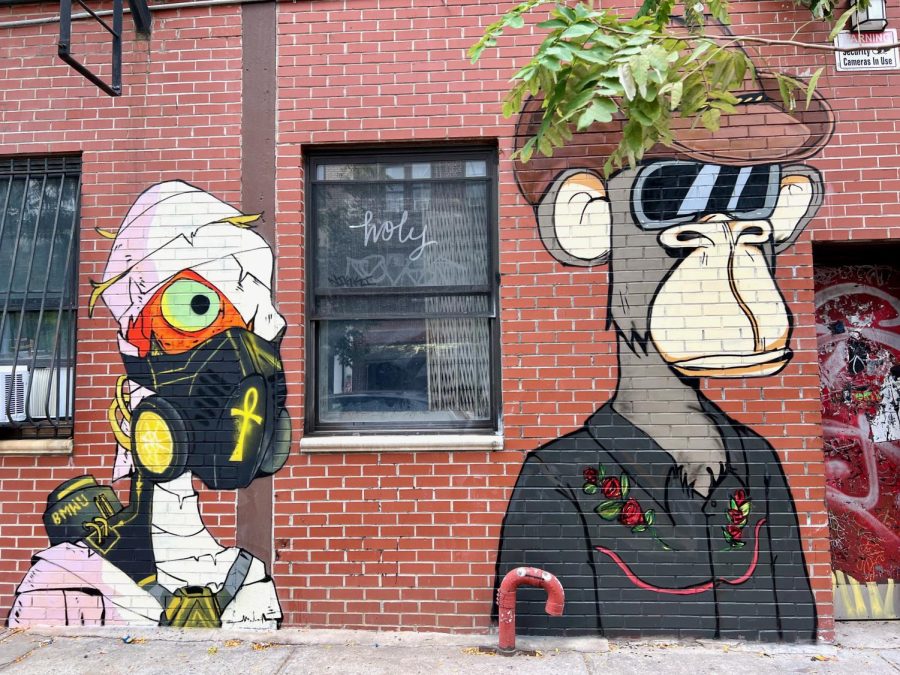What are NFTs?
A mural of NFT replications in Williamsburg, Brooklyn, done by Colombian street artist Masnah.
Non-fungible tokens, better known as NFTs, have had a recent spike in popularity during the past year, with rates of buyers and sellers increasing tremendously. With the popular cryptocurrency known as “Ethereum” adding NFTs to their blockchain, the token really started to see a true rise in the financial market. Ethereum counts for nearly 97% of all recent sales in the market, so it’s no surprise that they were the main contributing factor to NFTs substantial rise.
While NFTs only recently became a massively known digital item, they have actually been around since 2014, with the first known NFT titled “Quantum” being made by digital artist Kevin McCoy. Even before this though, the technical beginning of the idea behind the token began in 2012, with the start of colored coins made by the cryptocurrency known as Bitcoin. The coins were improvised creations of bitcoin miners, made with small denominations of Bitcoin that were used to represent other assets or things of value. This included assets such as coupons, property and digital subscriptions.
Controversy surrounding the topic of NFTs is high to say the least. With the large surge in very expensive purchases of NFT artwork recently, many critics of the idea have come forward with different issues about the tokens process. “Why not just screenshot it?”, many people say. Take a look at Cryptopunk #7523 for example. This NFT was sold for over 11 million dollars at Sothebys. Another NFT, created by Beeple, sold for an insane 69 million dollars at the “digital-only” auction at Christies. The auction house that sold the artwork has a history of selling very expensive items including “Salvator Mundi”, the painting of Jesus Christ that was sold for over 450 million dollars in 2017, bought by the current ruler of Saudi Arabia “King Salman”. So it’s safe to say that when the prestigious auction house had its first ever digital-only art sale and sold a piece for 69 million dollars, the NFT marketplace is definitely seeing growth at an astonishing rate. So, why would someone pay 69 million dollars for a piece of digital art that can be screenshotted for nothing? Good question.
One clear answer isn’t known. There are a few different speculations for these purchases. Being able to help support small creators that someone finds appealing and widen their popularity is one common reason. Another is for the money making opportunity. Crypto investors are seeing this as a way to buy and sell, with hopes of increasing the value of their tokens over time. Much like many coins on the crypto market, it’s the same process with NFTs for investors. However some people even buy a token just to show it off. Having that “sell” option is what ultimately separates the token itself from screenshots of people who want to have the artwork as well.
NFTs play a prominent role in allowing artists to further express themselves. While this digital method isn’t traditionally used, it is seen as a branch of art that has gained popularity in the modern era. Creating these small, pixel-by-pixel designs may seem odd to the average person, however, in reality it is just a new outlet for artists to use. Whether they strive to promote themselves or show off their work, this new digital database has been a net gain for the art community.
There are a few analysts who are very concerned about the NFTs process in a different light though, connecting it to money-laundering. Cryptocurrency coins were one major way that illegal money was “cleaned”, and now with NFTs being available, it’s even easier. NFTs can be purchased with crypto like ethereum and bitcoin, which just means another layer is available for those trying to clean their money. Let’s say someone creates their own NFT, then buys the NFT with the illicit funds they have, and then sells the artwork back to themselves. This way they started with dirty money but when putting it through an NFT, after selling the piece of art, the money appears legal.
It is common to see big social media influencers or TV networks promoting NFTs for their audience to buy. Since NFTs come in many different forms, people will often promote their work through media such as music, ebooks or videos in the form of an NFT. With this information, topics surrounding promoting NFTs are becoming much more relevant. As the cryptocurrency age becomes more and more popular, this promotion method could see much more light than it already has in the near future.
There has been rising conflict over this kind of use for the token. For example, this past June, popular content creator known as FaZe Kay was kicked out of his association (FaZe) due to his actions promoting a new cryptocurrency coin. Kay advertised an alternative/small coin known as “Save the Kids” in several videos urging his viewers to invest along with him in it. The conflict occurred when the coin plummeted in value and Kay was alleged to have performed a “pump and dump” (an illegal action where people will falsely advertise a stock/coin and then pull out all of their assets, dropping the price of after it has risen in popularity and went up in price) on the coin. Following the event, FaZe Kay was then cut by the association themselves, and some attorneys who have monitored the situation claim Kay could definitely suffer legal implications.
With this being said, it’s very clear to see that the market of NFTs have a lot of depth and are much more to the world than just simple art. Whether the future for NFTs and digital art in general is bright or showing signs of decline, there’s no doubt that the effect the token has had is substantial. While some see the token as a great way to open up a new form of buying, selling and promoting art pieces made by digital artists, others are definitely opposed to the idea and think it can cause more trouble than it can good fortune.










